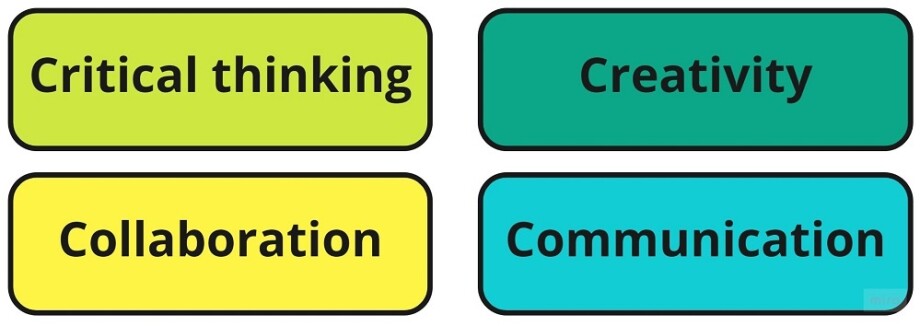You will ask what are the 4Cs about? What does it have to do with learning and education? Well, those are just 4 of the 12 other skills that are essential for today’s student to succeed in their careers. The 12 skills of the 21st century are:
- Critical thinking
- Creativity
- Collaboration
- Communication
- Information literacy
- Media literacy
- Technology literacy
- Flexibility
- Leadership
- Initiative
- Productivity
- Social skills
These are the skills that are critical for today’s learners to cope with the advancements of the information age and the development of technologies. While all twelve of those skills are necessary to teach, the «four C’s» (critical thinking, creativity, collaboration, communication) are often considered to be the most important ones.
Critical Thinking
Critical thinking is the ability to analyze situations and circumstances and arrive at balanced conclusions. It helps the students to view each situation from different perspectives and not to trust first impressions.
The basic idea of critical thinking is for the students to ask questions ‘why, how?’ and make decisions based on discovering facts for themselves rather than trust the existing and ready-made ones.
Some exercises that boost critical thinking are:
Follow up questions
Let’s say you have asked your students a question “What do you think you will be doing in 5 years’ time?” After eliciting the response, you might want to ask some follow-up questions to boost their critical thinking skills, like; “Why do you think so? What makes you think so? How can you support your plans?”, etc. This will help the students to develop reasoning skill.
Open-ended questions
Similarly, open-ended (WH questions) are a good way of developing critical thinking skills. Instead of asking ‘DO YOU’ questions (Do you like fast food?), it’s better to reformulate it (Why do you like fast food?). This again will give the students a chance to generate more language and think of supporting reasons to answer your question.
Debates
Encouraging healthy debates is another brilliant way to get the ball rolling. When debating, students again need to think about reasoning, give facts to support their viewpoint, etc. Ultimately, it helps them build arguments and generate more of the target language you’re aiming at.
Creativity
Another important skill to learn. Though some people might argue that creativity should come naturally to a person, it’s still possible to learn how to be creative with the right exercises and activities. Developing this skill in your students will help them solve difficult problems more successfully. It will also encourage out-of-box thinking.
Some of the tasks that can boost creativity in your classroom are:
Poster presentation
Students can be given a topic and asked to prepare a poster presentation around it. One that always works in my classrooms is to ask the students to create an advertising campaign about a product (the choice of the product is up to you). You might be surprised by how many nice ideas they will generate.
Drawing
Another fun way to boost creativity is drawing exercises. This is especially true for young learners. A fun way to go is to ask the students to finish an incomplete drawing. It can be anything. Below is a famous test introduced by psychologist Ellis Paul Torrance as a way to administer a more creatively inclined IQ test. Try this out. You will be pleasantly surprised on the number of interpretations you’ll get.

Find more ideas here.
Collaboration
If you ask me, this is the most important skill to begin with. Students will need this not only in the classroom to be able to communicate with their peers, but also later in their careers where they’ll have to collaborate with coworkers, people in business, etc.
Some of the proven ways to develop this skill are:
Pair/group works
Almost any exercise can be set to be performed in pairs and groups. It will not only give the teacher a chance to monitor the pace of the learners but will also greatly help to boost cooperation skills among the students. Group projects are very nice ways to do this.
Extracurricular activities
Other than the school work, you can encourage the students to do some work out of their normal learning environment. These can be projects again, presentations, field studies, etc. The main principle will be for the students to work together where everyone will need to pitch in to succeed in the project.
Find more tools here.
Another very important skill yet. The cornerstone of human interaction without which the rest will not matter. It is not a secret that alongside the development of different social media platforms and the Internet in general, people are losing basic face to face interaction skills. This can result in failure to communicate important ideas, messages which will bring to a failure in a project, job, business, etc. How to teach this skill?/p>
Speaking tasks and exercises
In every language classroom, there is a section of the lesson devoted to production where students need to test the knowledge they’ve received. This is where it is quite easy to teach the skill of communication to the students though speaking activities where students need to discuss a list of questions, debate on some topics, talk to each other to solve some issues, etc.
To sum up, it is important to bear in mind, that these skills should not and cannot be taught separately. They will reach their goal only as a group. If you look closely, all our sessions have an aspect of some of those skills whether we realize it while planning the session or not. So, why not to think a bit deeper before planning the next lesson to make sure that the 4Cs are integrated into our teaching in the best possible way.






 Маргарита Аветисян
Маргарита Аветисян 
 Вероника Аветисян
Вероника Аветисян 


